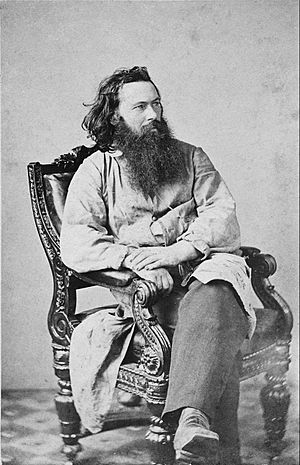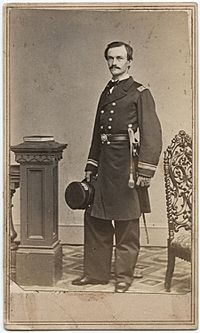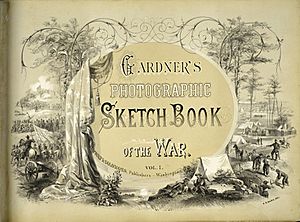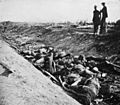Alexander Gardner (photographer) facts for kids
Quick facts for kids
Alexander Gardner
|
|
|---|---|

Gardner c. 1863
|
|
| Born | October 17, 1821 Paisley, Renfrewshire, Scotland
|
| Died | December 10, 1882 (aged 61) Washington, D.C., U.S.
|
| Resting place | Glenwood Cemetery |
| Citizenship | United Kingdom, United States |
| Occupation | Photographer |
| Spouse(s) | Margaret Gardner |
| Children | 2 |
Alexander Gardner (born October 17, 1821 – died December 10, 1882) was a Scottish photographer. He moved to the United States in 1856 and became a full-time photographer. He is famous for his pictures of the American Civil War. He also took photos of U.S. President Abraham Lincoln. Gardner documented the people involved in the plot to assassinate Lincoln. He also photographed their execution.
Contents
Early Life and Photography Beginnings
Alexander Gardner was born in Paisley, Scotland, on October 17, 1821. When he was 14, he started training to be a jeweler. This training lasted for seven years.
Gardner was interested in creating a special community in the United States. This community would be based on ideas of working together and sharing. In 1850, he and others bought land in Iowa for this purpose. However, Gardner went back to Scotland to raise more money. He stayed there until 1856. During this time, he became the owner and editor of a newspaper called the Glasgow Sentinel.
In 1851, Gardner visited The Great Exhibition in London. There, he saw photographs by an American named Mathew Brady. This sparked Gardner's interest in photography.
In 1856, Gardner and his family moved to the United States. He found that many friends at the community he helped start were very sick. So, he stayed in New York. Gardner contacted Mathew Brady and became his assistant that same year. He worked for Brady until 1862. At first, Gardner focused on making large photos. These were called Imperial photographs. As Brady's eyesight got worse, Gardner took on more responsibility. In 1858, Brady put Gardner in charge of his photography studio in Washington, D.C..
Documenting History: Gardner's Photography Career
Photographing the American Civil War
When Abraham Lincoln became President in 1860, there was a threat of war. Gardner was in Washington, D.C., which was a good place to record events before the war. He became well-known for taking portraits of soldiers. These soldiers were leaving for the war.
Mathew Brady wanted to photograph the Civil War. Gardner helped him share this idea with President Lincoln. Gardner knew Allan Pinkerton, who was in charge of a spy group. Pinkerton suggested Gardner for the job of chief photographer. This job was under the U.S. Topographical Engineers. After this short role, Gardner became a staff photographer for General George B. McClellan. McClellan was the commander of the Army of the Potomac. At this point, Gardner stopped managing Brady's gallery.
Gardner was given the honorary rank of captain. He photographed the Battle of Antietam in September 1862. He used a special traveling darkroom to develop his photos. Gardner's pictures were so clear that families could recognize their loved ones in them.
Many of Gardner's photos have been mistakenly credited to Brady. Even though Gardner took many pictures, historians have not always given him full credit. In November 1862, Lincoln removed General McClellan from command. Gardner's role as the main army photographer became smaller. Around this time, Gardner stopped working with Brady. This was likely because Brady often put his own name on photos taken by his employees.
That winter, Gardner followed General Ambrose Burnside. He photographed the Battle of Fredericksburg. Next, he followed General Joseph Hooker. In May 1863, Gardner and his brother James opened their own studio in Washington, D.C. Many of Brady's former staff came to work for them. Gardner photographed the Battle of Gettysburg in July 1863. He also documented the Siege of Petersburg from 1864 to 1865.
In 1866, Gardner published a two-volume book. It was called Gardner's Photographic Sketch Book of the Civil War. Each volume had 50 original photos glued inside. The book did not sell very well. Not all the photos were taken by Gardner himself. He gave credit to the person who took the negative and the person who printed the picture. As the owner of the studio, Gardner owned the work produced there. The book included photos by Timothy H. O'Sullivan, James F. Gibson, and others.
Gardner took several photos of Abraham Lincoln. Some of these were thought to be the last pictures taken of the President before his assassination. However, it was later found that these photos were taken in February 1865. Gardner photographed Lincoln a total of seven times during his life. He also documented Lincoln's funeral. He photographed the people involved in Lincoln's assassination. Gardner was the only photographer allowed to take pictures at their execution by hanging. These photos were later turned into woodcuts for Harper's Weekly magazine.
After the War: New Adventures
After the Civil War, Gardner was asked to photograph Native Americans. They came to Washington to discuss peace treaties. He also surveyed the path for the proposed Kansas Pacific railroad to the Pacific Ocean. Many of his photos from this time were stereoscopic, which means they created a 3D effect.
After 1871, Gardner stopped working as a photographer. He helped start an insurance company. Gardner lived in Washington, D.C., until he died. When asked about his work, he said he hoped his photos would be a lasting memory of the difficult war. He became ill in late 1882 and died on December 10, 1882. He was buried in Glenwood Cemetery in Washington, D.C.
In 1893, a photographer named J. Watson Porter found hundreds of glass negatives made by Gardner. They had been left in an old house where Gardner used to live. This discovery led to a story in the Washington Post newspaper. It brought new interest to Gardner's amazing photographs.
Gallery
-
Middle bridge over Antietam Creek, September 1862.
-
Abraham Lincoln, Allan Pinkerton and John Alexander McClernand, visiting the Antietam battlefield, 1862.
-
The "Gettysburg Portrait", A head-on photograph of Abraham Lincoln taken on November 8, 1863; eleven days before his Gettysburg Address.
-
[Bottom] Harper's Weekly drawing showing autopsy of John Wilkes Booth on the USS Montauk (1862). (Based on a lost Alexander Gardner photograph (?))
-
David Herold, involved in the assassination plot, after arrest, 1865.
-
George Atzerodt, involved in the assassination plot, after arrest, 1865.
See Also
 In Spanish: Alexander Gardner para niños
In Spanish: Alexander Gardner para niños
- Photographers of the American Civil War
- David Hume Kennerly (influenced by Gardner)




























